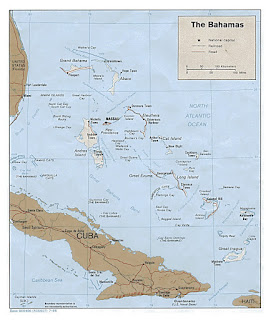Reflection on The Intertwined Destinies of The Bahamas and Cuba
The Shared History of Cuba and The Bahamas
Cuba and Ragged Island: A Fascinating History, Saluting Fishermen and Fruitful Exchanges
By Dr. Kevin Turnquest-Alcena
Nassau, The Bahamas
Our journey through the storied connections between The Bahamas and Cuba reveals a saga of endurance, exploration, and exchange, woven by the diligent Cuban fishermen. Their voyages transcended mere trade, fostering lasting friendships and cultural bonds that resonate to this day. We dive into this rich narrative, celebrating the shared history and unbreakable ties between these vibrant islands.
The Natural Connection: Limestone and Rich Soil
The Bahamas and Cuba are siblings of the sea, their lands cradled by limestone and nurtured by fertile soils. This geological kinship hints at a shared past and has sculpted both the landscape and the life it supports. Cuba's lush terrain complements The Bahamas' stunning shores, creating a diverse tapestry of ecosystems that enrich both regions. These natural blessings foster a unique blend of environments, where life thrives in harmony.
The Story of Camagüey and The Bahamas
In the heart of Cuba, Camagüey stands as a beacon of agricultural bounty, pivotal in the exchange of goods and culture with The Bahamas. This history of mutual benefit and shared growth showcases the power of community and cooperation across waters. Through the sharing of harvests and traditions, Camagüey and The Bahamas have woven a narrative of interdependence and resilience, celebrating the richness of combined cultures.
The Fishermen's Legacy
We honor the Cuban fishermen, whose journeys to Ragged Island and beyond are foundational tales of Caribbean solidarity. More than traders, these men were bridge-builders, connecting communities with every voyage. Their legacy, steeped in the spirit of unity and shared prosperity, has significantly shaped the Caribbean identity, reminding us of the enduring strength found in connection and shared purpose.
More Than Just Trading
The barter system initiated by these seafarers did more than exchange goods; it wove a fabric of interconnected lives, blending cultures, ideas, and families. This vibrant mosaic of exchanges has deeply influenced the Bahamian lifestyle, introducing a wealth of fruits and vegetables that enrich daily life. Celebrating this cultural fusion, we acknowledge the profound connections that have grown from these shared experiences.
A Link Through Time: The Cuban Crocodiles of Abaco
In the discovery of Cuban crocodile fossils in Abaco, we find a tangible link to a shared ancient past. This remarkable find not only highlights the biological ties between Cuba and The Bahamas, but also suggests deep, historical connections that predate modern exchanges. The presence of these ancient creatures in Bahamian soil speaks to a time when land and life flowed freely between these islands, adding a fascinating prelude to the story of Cuban and Bahamian unity.
Broadening the Horizon: From Mexico to Cuba and The Bahamas
The narrative broadens to include the pathways from Mexico's Yucatán Peninsula through Cuba to The Bahamas, tracing the routes of early exchanges. This expansive view enriches our understanding of the Caribbean's complex history, where land and sea routes facilitated not only the movement of goods - but also the spread of cultures and communities across this vibrant region.
Conclusion
Reflecting on the intertwined destinies of the Bahamas and Cuba, we celebrate the legacy of exchange and camaraderie that defines their relationship. Through tales of Camagüey, the valorous fishermen, and the ancient crocodiles of Abaco, we honor the spirit of cooperation that has forged indelible bonds across the Caribbean. This shared history, rich with lessons of unity and friendship, stands as a testament to the enduring power of collective heritage and mutual respect.
This article offers a gateway to the deep and vibrant history connecting Cuba and Ragged Island, paying homage to the fishermen and the complex web of exchanges that have brought our communities together, underscored by the ancient, ecological ties that bind.

